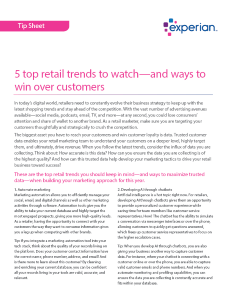1. Automating marketing
Marketing automation allows you to efficiently manage your social, email, and digital channels as well as other marketing activities through software. Automation tools give you the ability to take your current database and highly target the most engaged prospects, giving you more high-quality leads. As a retailer, having the opportunity to connect with your customers the way they want to consume information gives you a leg up when competing with other brands.
Tip: If you integrate a marketing automation tool into your tech stack, think about the quality of your records living on the platform. Does your customer contact information have the correct name, phone number, address, and email? And is there more to learn about this customer? By cleaning and enriching your current database, you can be confident all your records living in your tools are valid, accurate, and relevant.
2. Developing AI through chatbots
Artificial intelligence is a hot topic right now. For retailers, developing AI through chatbots gives them an opportunity to provide a personalized customer experience while saving time for team members like customer service representatives. How? The chatbot has the ability to simulate a conversation via messenger interfaces or over the phone, allowing customers to quickly get questions answered, which frees up customer service representatives to focus on the higher escalation cases.
Tip: When you develop AI through chatbots, you are also giving your business another way to capture customer data. For instance, when your chatbot is connecting with a customer online or over the phone, you are able to capture valid customer emails and phone numbers. And when you automate monitoring and profiling capabilities, you can ensure the data you are collecting is constantly accurate and fits within your database.
On top of that, you can also understand what pain points your customers have: What questions are most frequently asked? What concerns are most frequently addressed? This data can pivot your marketing strategy to best accommodate your customer’s needs and wants to get you ahead of the competition.
3. Adding delivery and pick-up options
Customers today want convenience. And convenience can mean something different to each customer. That’s why having delivery and pick-up options for your customers have been a priority for many retailers. A perfect example: Amazon, the retail giant. Amazon brought the expectation of one-day delivery to the market and then introduced pick-up options. This way customers can choose what the best option is for them.
Tip: Trying to determine what option is best for your customers? Look at your customers’ demographics. With accurate, relevant, and enriched data, you will be able to confidently analyze where your customers live, work, consume information, and you can predict their shopping habits giving you the insights you need to determine your next play: implementing one-day delivery to loyalty members, a pick-up location with a local store partnership, or both.
4. Boosting social media presence
Enter: social media—a land that has changed the game of shopping. According to Animoto, “In 2019, 60 percent of consumers who made a purchase from a brand found out about them on social media.”1 As social media platforms like Instagram, Facebook, Twitter, and LinkedIn continue to evolve, so does the consumer. For retailers, this is a huge opportunity to show your customers the true value of your products and to personally engage with each and every customer. The challenge here? Maintaining a consistent brand appearance and steady customer experience across all channels.
When customers have a streamlined experience across all your channels—social media, email, and your website—your brand automatically becomes more trustworthy. As a retailer, having a dependable brand is the key to success when influencing your customers to purchase with you.
Tip: With enriched data, you can be certain you are on the right social media platforms to capture your customers’ attention. Enriched data gives you a deeper understanding of your customers, what their shopping habits are, and more by appending a variety of data attributes—like, financial data, buyer propensity, and automotive data—to your database. When you have evidence that outlines your customers’ shopping tendencies, you can be confident that boosting your social media presence is worth your time and money.
5. Driving a personalized customer experience
The trends listed above give you the chance to drive a personalized customer experience. For a saturated market like the retail industry, a unique customer experience is the differentiator between you and your competitor—and, a personalized experience is what customers expect. So, how do you accomplish that? Make sure you are understanding your customers’ wants and needs on an individual level and strategically target your customers in a way that best motivates them to purchase with you.
Tip: To understand and connect with your customers in the best way possible, you need to be confident in your customers’ contact data. Data is the tangible evidence that can pivot your marketing strategy toward success. Your first step is to capture valid data at the point of sale. With tools that predict and auto-fill correct contact information when checking out online or in-store, you make your customer experience is quick and easy while collecting valid information so you can highly target them in the future.
Today, retailers have to keep up with these trends to stay ahead of the competition. But with so many ways to connect with customers and drive sales, you can find yourself in a disjointed state. With trusted data, you can take a step back and confidently analyze your customers. With reliable customer contact records, insights, and transactions, you can strategically determine your digital placement and be confident every marketing effort is reaching your consumers.



